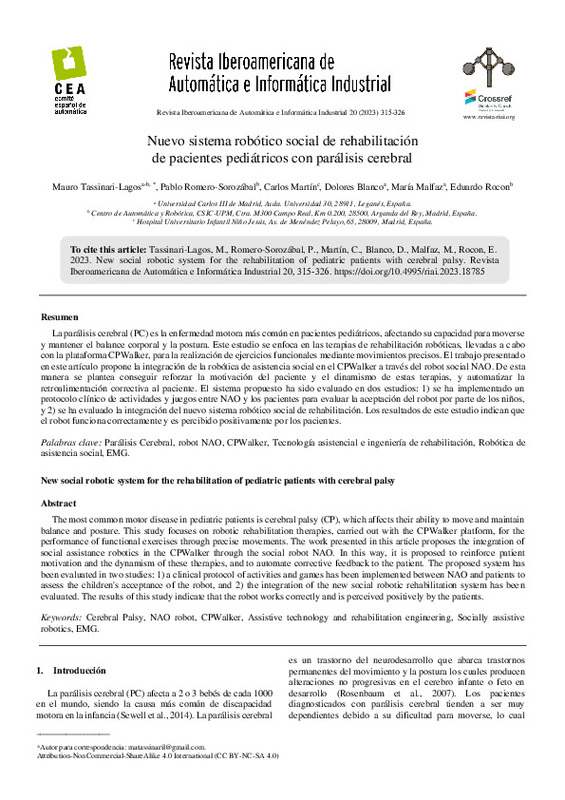Bartlett, D. J., & Palisano, R. J. (2002). Physical Therapists’ Perceptions of Factors Influencing the Acquisition of Motor Abilities of Children With Cerebral Palsy: Implications for Clinical Reasoning. Physical Therapy, 82(3), 237–248. https://doi.org/10.1093/PTJ/82.3.237
Bartneck, C., Kulić, D., Croft, E., & Zoghbi, S. (2009). Measurement Instruments for the Anthropomorphism, Animacy, Likeability, Perceived Intelligence, and Perceived Safety of Robots. International Journal of Social Robotics, 1(1), 71–81. https://doi.org/10.1007/s12369-008-0001-3
Bayón, C. (2018). Design, Development and Evaluation of a Robotic Platform for Gait Rehabilitation and Training in Patients with Cerebral Palsy [Universidad Carlos III de Madrid]. http://hdl.handle.net/10261/167024
[+]
Bartlett, D. J., & Palisano, R. J. (2002). Physical Therapists’ Perceptions of Factors Influencing the Acquisition of Motor Abilities of Children With Cerebral Palsy: Implications for Clinical Reasoning. Physical Therapy, 82(3), 237–248. https://doi.org/10.1093/PTJ/82.3.237
Bartneck, C., Kulić, D., Croft, E., & Zoghbi, S. (2009). Measurement Instruments for the Anthropomorphism, Animacy, Likeability, Perceived Intelligence, and Perceived Safety of Robots. International Journal of Social Robotics, 1(1), 71–81. https://doi.org/10.1007/s12369-008-0001-3
Bayón, C. (2018). Design, Development and Evaluation of a Robotic Platform for Gait Rehabilitation and Training in Patients with Cerebral Palsy [Universidad Carlos III de Madrid]. http://hdl.handle.net/10261/167024
Booth, A. T. C., Buizer, A. I., Meyns, P., Oude Lansink, I. L. B., Steenbrink, F., & van der Krogt, M. M. (2018). The efficacy of functional gait training in children and young adults with cerebral palsy: a systematic review and meta-analysis. Developmental Medicine and Child Neurology, 60(9), 866–883. https://doi.org/10.1111/DMCN.13708
Céspedes Gómez, N., Vivian, A., Echeverria, C., Munera, M., Bogotá, J. G., Rocon, C. E., Cifuentes, C. A., Calderon Echeverria, A. V., & Rocon, E. (2021). First interaction assessment between a social robot and children diagnosed with cerebral palsy in a rehabilitation context. ACM/IEEE International Conference on Human-Robot Interaction, 484–488. https://doi.org/10.1145/3434074.3447219
Comunidad de Madrid. (2022). Hospital Infantil Universitario Niño Jesús. https://www.comunidad.madrid/hospital/ninojesus/. (Último acceso: 8/10/2022).
Delsys Incorporated. (2022). Trigno® Avanti Sensor - Delsys. https://delsys.com/trigno-avanti/. (Último acceso: 2/07/2022).
Díaz, I., Gil, J. J., & Sánchez, E. (2011). Lower-Limb Robotic Rehabilitation: Literature Review and Challenges. Journal of Robotics, 2011, 1–11. https://doi.org/10.1155/2011/759764
Fasoli, S. E., Ladenheim, B., Mast, J., & Krebs, H. I. (2012). New horizons for robot-assisted therapy in pediatrics. American Journal of Physical Medicine and Rehabilitation, 91(11 SUPPL.3). https://doi.org/10.1097/PHM.0B013E31826BCFF4
Gardinier, E. S. (2009). The Relationship Between Muscular Co-Contraction and Dynamic Knee Stiffness in ACL-Deficient Non-Copers [University of Delaware]. https://udspace.udel.edu/handle/19716/4251
Kozyavkin, V., Kachmar, O., & Ablikova, I. (2014). Humanoid social robots in the rehabilitation of children with cerebral palsy. Proceedings - REHAB 2014, 430–431. https://doi.org/10.4108/ICST.PERVASIVEHEALTH.2014.255323
Law, M., Darrah, J., Pollock, N., King, G., Rosenbaum, P., Russell, D., Palisano, R., Harris, S., Armstrong, R., & Watt, J. (2009). Family-Centred Functional Therapy for Children with Cerebral Palsy. Physical & Occupational Therapy In Pediatrics, 18(1), 83–102. https://doi.org/10.1080/J006V18N01_06
Max Planck Institute for Psycholinguistics, The Language Archive, N. (2022). ELAN [computer software] (6.3). https://archive.mpi.nl/tla/elan
Meyer-Heim, A., & van Hedel, H. J. A. (2013). Robot-Assisted and Computer-Enhanced Therapies for Children with Cerebral Palsy: Current State and Clinical Implementation. Seminars in Pediatric Neurology, 20(2), 139–145. https://doi.org/https://doi.org/10.1016/j.spen.2013.06.006
Pulido, J. C., González, J. C., Suárez-Mejías, C., Bandera, A., Bustos, P., & Fernández, F. (2017). Evaluating the Child–Robot Interaction of the NAOTherapist Platform in Pediatric Rehabilitation. International Journal of Social Robotics, 9(3), 343–358. https://doi.org/10.1007/s12369-017-0402-2
Pulido Pascual, J. C. (2020). Autonomous socially assistive robotics in pediatric clinical practice [Universidad Carlos III de Madrid]. http://hdl.handle.net/10016/31276
Rosenbaum, P., Paneth, N., Leviton, A., Goldstein, M., & Bax, M. (2007). A report: the definition and classification of cerebral palsy April 2006. Developmental Medicine & Child Neurology, 49(SUPPL. 2), 8–14. https://doi.org/10.1111/J.1469-8749.2007.TB12610.X
Sewell, M. D., Eastwood, D. M., & Wimalasundera, N. (2014). Managing common symptoms of cerebral palsy in children. BMJ, 349. https://doi.org/10.1136/BMJ.G5474
Shamsoddini, A., Amirsalari, S., Hollisaz, M.-T., Rahimnia, A., & Khatibi-Aghda, A. (2014). Management of Spasticity in Children with Cerebral Palsy. Iranian Journal of Pediatrics, 24(4), 345. https://www.ncbi.nlm.nih.gov/pmc/articles/PMC4339555/
SoftBank Robotics. (2022). NAO the humanoid and programmable robo. https://www.softbankrobotics.com/emea/en/nao. (Último acceso: 07/10/2022).
Taylor, T. (2019). Muscles of the Leg and Foot. https://www.innerbody.com/anatomy/muscular/leg-foot
Vallery, H., van Asseldonk, E. H. F., Buss, M., & van der Kooij, H. (2009). Reference Trajectory Generation for Rehabilitation Robots: Complementary Limb Motion Estimation. IEEE Transactions on Neural Systems and Rehabilitation Engineering, 17(1), 23–30. https://doi.org/10.1109/TNSRE.2008.2008278
[-]








